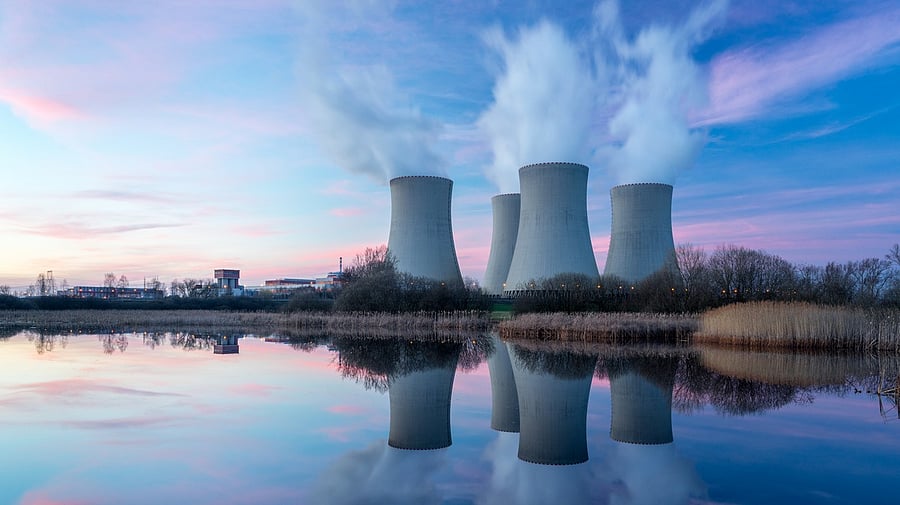
Image showing a nuclear reactor. For representational purposes.
Credit: iStock Photo
Bengaluru: In the past decade India added 4GW to its nuclear power capacity. But the country is dreaming of adding 100 GW in the next 24 years, or by 1947. To this end, on Saturday the Finance Minister Nirmala Sitharaman announced plans for amending the Atomic Energy Act and the Civil Liability for Nuclear Damage Act, to enable greater private participation in the sector.
While it raised a few eyebrows about dismantling legal guardrails for an energy source that raises safety concerns and waste management risks, it also raised expectations of getting India closer to its green energy targets, given that renewable sources like wind and solar are intermittent, while nuclear is stable.
The proposal for an outlay of Rs 20,000 crore for the Nuclear Energy Mission towards research and development of small modular reactors, in the hope of getting at least five indigenous ones operationalised by 2033, is likely to pump up the private players' keenness to invest in such stable assets. Yet, industry experts DH spoke to pointed to a path fraught with a multitude of challenges.
Vivek Jain, Director, India Ratings and Research, said, “Current challenges include designing these reactors and developing indigenous technology in the first place, for which a fair bit of work needs to be done. Another is whether private players pick up on technology that may not have yet achieved commercial scale. One thing to look out for is how the tariff determination process is allowed for the private sector, because you will need to be compensated for the risk that you take on a new technology.”
He added that policy amendments will primarily be about fuel sourcing and if it can be done independently. It is currently done by the Atomic Energy Regulatory Board, which is likely to continue.
For the private sector, what matters is clarity on regulatory processes, the expected returns from their investments, and execution challenges they may face, said Vikram V, Vice President and Co-Group Head, Corporate Ratings, ICRA Limited.
Foreign interest in investing and setting up projects is also expected as a long-term result of these announcements, depending on the frameworks established. Experts mentioned the acceleration that could be brought to the sector by partnerships with foreign nuclear players.
However, there are challenges on this front as well.
“Currently, we have two nuclear equipment operators - government-owned entities like the Nuclear Power Corporation of India and BHAVINI in India. As per the current CLND Act 2010, if equipment goes faulty due to any accident, the liability on suppliers is uncapped. That is a major deterrent for major foreign suppliers like GE Hitachi Nuclear Energy, Westinghouse Electric Company, and Rosatom State Corporation,” said G Venkatakuppuswamy, ESG Expert Committee member of Bangalore Chamber of Industry and Commerce (BCIC) and Director Key Accounts, LRQA Ltd.
He said, “Furthermore, aligning with international conventions such as the Convention on Supplementary Compensation for Nuclear Damage will be essential. This alignment would not only reassure global nuclear players but also facilitate the development of a structured insurance framework to support those affected—an aspect currently lacking.”
Another comes with public threat perception, with analysts expecting backlash especially from the Opposition. Concerns such as leakage and waste management were highlighted as critical.
For example, Venkatakuppuswamy said, the Kovvada nuclear power project in Andhra Pradesh (which involves Westinghouse) has not taken off because the acquisition of land itself has been a problem brought on by public backlash. As a result, he anticipates amendments or relaxations in the Civil Liability for Nuclear Damage Act of 2010.
The process itself is expected to be long, analysts said, from policy amendments to the projects themselves that could take up to a decade.
One analyst mentioned that the country is unlikely to see new projects getting commissioned before 2030 – which is quite close to the government’s 2033 goal.
Overall, analysts agree that things are expected to be slow with policy amendments, projects and reactors taking several years to develop, and foreign investments appear to be quite far into the future.
“One thing that can disrupt this market is if private sector players themselves start looking at technology solutions, based on what the amended Acts look like,” said Jain.
Not everybody is convinced that the government’s move on nuclear energy is another appeasement on offer to the Trump administration. "The government has been talking about scaling up nuclear for a very long time, even in the last Budget," said ICRA's Vikram V.
"India’s increased focus on green and nuclear energy aligns with global efforts to combat climate change. Strengthening energy ties with the US under initiatives like this could deepen trade relations and foster technology sharing," said Sandiip Bhammer, Founder and Managing Partner, Green Frontier Capital.